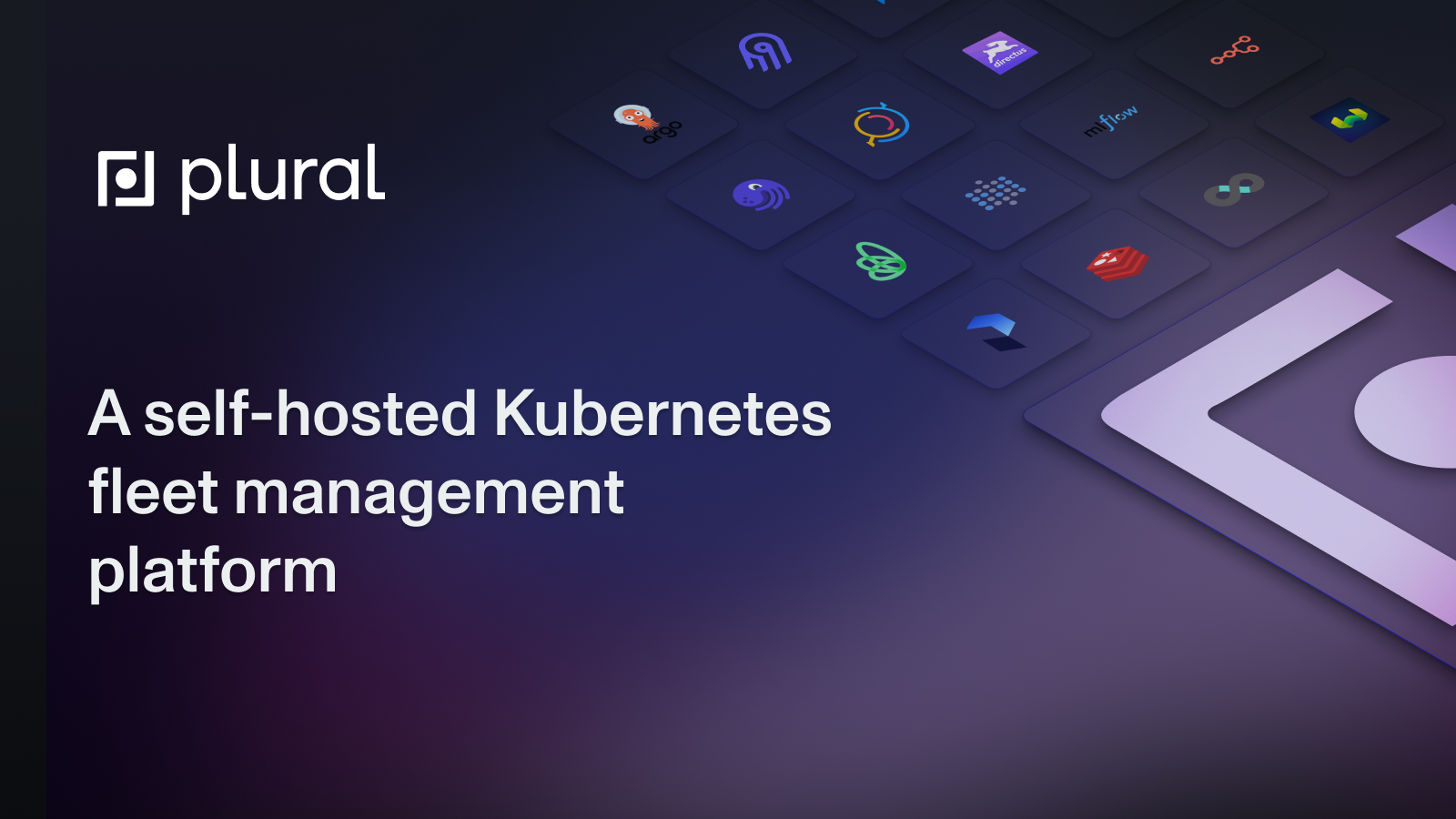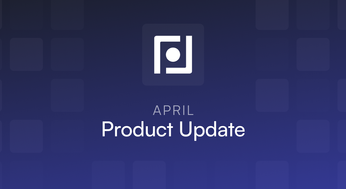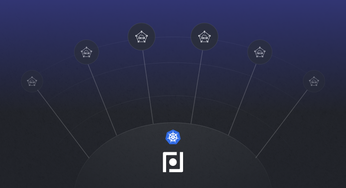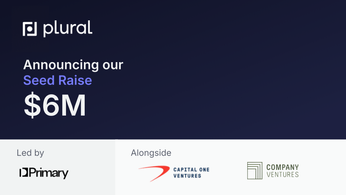
Kubernetes GitOps with Argo: Where to Go Next
Learn how to effectively manage Kubernetes with Argo. This practical guide covers Argo tools and how you can go even further with Kubernetes with Plural.
Table of Contents
Kubernetes offers immense power for container orchestration, but its flexibility often comes with complexity. The Argo project simplifies Kubernetes management by providing purpose-built tools for workflows, deployments, and GitOps practices.
This post explores how Argo enhances the Kubernetes experience, from automating complex tasks with Argo Workflows to implementing robust continuous delivery with Argo CD. We'll also explore advanced deployment strategies with Argo Rollouts and event-driven automation with Argo Events. While Argo CD provides a good starting point for GitOps workflows, enterprise environments often require more sophisticated solutions for multi-cluster deployments. We'll also introduce Plural CD, an advanced continuous deployment solution that builds upon GitOps principles with enhanced capabilities for multi-cluster orchestration, global services management, and integrated observability.
Unified Cloud Orchestration for Kubernetes
Manage Kubernetes at scale through a single, enterprise-ready platform.
Key Takeaways
- Argo simplifies Kubernetes complexity: Its component tools streamline workflows, from task orchestration with Argo Workflows to continuous delivery with Argo CD and advanced deployments with Argo Rollouts.
- GitOps enables declarative Kubernetes management: Argo CD uses Git as the source of truth, automating deployments and ensuring consistency between your repository and cluster. For enterprise needs, Plural CD offers a comprehensive solution for continuous delivery that builds upon the GitOps principles established by ArgoCD.
- Security and scalability require proactive measures: Secure your Argo deployments with RBAC and vulnerability management. For large-scale Kubernetes fleets, consider a comprehensive management platform such as Plural to address operational challenges and ensure consistent security policies.
What is Argo, and How Does It Enhance Kubernetes?
What is Argo?
The Argo project offers a set of open-source tools that are purpose-built for Kubernetes. These tools streamline workflows, manage clusters, and improve GitOps practices. Argo comprises several components, including Argo Workflows, Argo CD, Argo Rollouts, and Argo Events, each addressing specific needs within the Kubernetes ecosystem. For instance, Argo Workflows enables managing complex, multi-step tasks by breaking them into smaller, containerized jobs, which is ideal for CI/CD pipelines and data processing.
How Argo Integrates with Kubernetes
Argo seamlessly integrates with Kubernetes, providing a robust framework for automation. Argo Workflows run directly on Kubernetes, allowing you to define complex parallel workflows as Kubernetes resources. This simplifies orchestration for tasks like CI/CD pipelines and machine learning workflows. Argo CD continuously monitors the desired application state defined in your Git repository and compares it to the actual running state in your Kubernetes cluster. Any discrepancies trigger automatic reconciliation, ensuring consistency and reliability. This GitOps approach, where Git becomes the source of truth for deployments, streamlines updates and rollbacks. By leveraging Kubernetes' existing infrastructure, Argo enhances operational efficiency and simplifies the management of application lifecycles.
Argo Project Core Components
This section introduces the core components of the Argo project, outlining their functionalities and how they enhance Kubernetes deployments.
Argo Workflows: Orchestrating Complex Tasks
Argo Workflows is a Kubernetes-native workflow engine for orchestrating complex jobs and applications. It allows you to define workflows as a sequence of steps or Directed Acyclic Graphs (DAGs), where each step runs in a container. This container-native approach makes Argo Workflows ideal for CI/CD pipelines, machine learning tasks, and other data processing applications. You define these workflows in YAML, making them portable and version-controlled. Argo Workflows excels at managing dependencies between steps, ensuring correct execution order, and handling failures gracefully.
Argo CD: Implementing GitOps for Deployments
Argo CD is a declarative, GitOps continuous delivery tool designed explicitly for Kubernetes. It uses Git repositories as the source of truth for the desired application state. This means your deployments are managed and tracked through Git, simplifying rollback and audit trails. Argo CD continuously monitors your cluster and compares its live state against the desired state defined in your Git repository. If any drift is detected, Argo CD automatically synchronizes your cluster to match the Git configuration. This automation ensures consistent deployments and reduces manual intervention.
How Plural Compares to ArgoCD
While Argo CD provides robust GitOps workflows for individual clusters, organizations managing multiple Kubernetes environments often face scaling challenges. This is where Plural CD extends these capabilities with its advanced GitOps-based workflow. Like Argo CD, Plural CD ensures Kubernetes manifests remain in sync with source code repositories, but it includes multi-cluster orchestration, observability, and Global Services designed for enterprise-scale Kubernetes management.


Argo Rollouts: Advanced Deployment Strategies
Argo Rollouts enhances Kubernetes deployments by providing advanced deployment strategies like Canary and Blue/Green deployments. These strategies minimize disruption during updates by gradually shifting traffic to new versions. Canary deployments allow you to test new versions with a small subset of users. In contrast, Blue/Green deployments maintain two separate environments, switching traffic between them once the new version is validated. Argo Rollouts integrates with metrics providers to monitor the health of new deployments, automatically pausing or rolling back if issues are detected.
Argo Events: Enabling Event-Driven Architectures
Argo Events is an event-based dependency manager for Kubernetes. It allows you to trigger workflows or other actions based on various events, such as webhooks, S3 updates, or message queue activity. This enables you to build reactive and event-driven applications within your Kubernetes cluster. Argo Events bridges external systems and your internal workflows, automating responses to changes and fostering a more dynamic environment.
Streamlining Kubernetes Workflows with Argo
Let's explore how Argo Workflows streamlines orchestrating complex tasks and parallel workflows directly within Kubernetes.
Simplify Complex Task Management
Managing complex tasks in Kubernetes can be challenging. Argo Workflows provides a robust solution as a sophisticated scheduler for containerized jobs. Think of it as a powerful orchestrator that handles the complexities of your computing tasks, running seamlessly within your Kubernetes environment.
Execute DAG and Step-Based Workflows
Argo Workflows excels at orchestrating complex, parallel workflows. This capability is particularly valuable for CI/CD pipelines and machine learning workflows, where tasks often depend on each other and must be executed in a specific order. Argo Workflows enables you to define these workflows as Directed Acyclic Graphs (DAGs) or step-based processes, ensuring efficient execution and management of dependencies, improving overall efficiency, and reducing operational overhead.
GitOps in Action: Argo CD, Kubernetes, and Continuous Deployment
This section explores how Argo CD facilitates GitOps, automates deployments, and enhances security.
Understand GitOps Principles
GitOps uses your Git repository as the single source of truth for your desired application state. This declarative approach means your Git commit history defines what runs in your Kubernetes cluster. Using Git for operations provides several benefits, including increased transparency, improved collaboration, and easier rollback capabilities. Any change to your infrastructure or applications is tracked within your Git repository, simplifying auditing and change management.
How Argo CD Facilitates GitOps
Argo CD continuously monitors your Kubernetes cluster and compares its current state against the desired state defined in your Git repository. When it detects a difference—for example, a new application version or a configuration update—Argo CD automatically synchronizes your cluster to match the Git repository. This automated synchronization ensures that your deployments always reflect the desired state, reducing manual intervention and minimizing configuration drift. Argo CD acts as a controller, constantly observing and adjusting your cluster. You can visualize this process and track the deployment status directly within the Argo CD UI.
Scaling GitOps with Plural CD
Argo CD provides a solid foundation for GitOps practices in individual clusters; however, enterprises managing complex multi-cluster environments face additional challenges. Plural CD expands on these GitOps principles with its sophisticated pipeline system for fleet management, designed for coordinated, staged rollouts across multiple clusters. This system introduces automated PR-based workflows with approval gates and validation controls, bringing GitOps practices to enterprise scale.

Plural CD's approach to codebase management enhances GitOps by supporting popular tools like Helm and Kustomize while promoting code reusability and testability. Its architecture helps maintain clean, organized Kubernetes configurations across multiple environments. For organizations needing to manage global services—such as cert-manager, ingress controllers, and service meshes—Plural CD provides centralized definition and deployment capabilities, ensuring consistent configuration across all clusters while adhering to core GitOps principles.

Advanced Kubernetes Deployment Techniques Using Argo Rollouts
Argo Rollouts enhances Kubernetes deployments by providing sophisticated rollout strategies like canary and blue-green deployments. These strategies minimize disruption and risk during application updates.
Implement Canary and Blue-Green Deployments
Canary deployments involve gradually shifting traffic to a new version of your application. A small subset of users (the “canaries”) experience the new version first, allowing you to monitor performance in a real-world environment before full rollout. If issues surface, you can quickly revert the changes, limiting user impact. Blue-green deployments maintain two identical environments: “blue” (live) and “green” (staging). Updates deploy to the green environment, undergo testing, and then traffic switches over, making green live. This approach allows for a rapid rollback if necessary.
Minimize Risks During Application Updates
Argo Rollouts provides a robust framework for managing progressive deployments. By incrementally releasing updates and monitoring their impact, you reduce the risks associated with application updates. Automated rollbacks, triggered by metrics or analysis, ensure that if a deployment fails health checks or performance degrades, the rollout automatically reverts to the previous stable version. This automated response minimizes downtime and maintains application stability.
Fine-tune Deployment Strategies for Kubernetes
Argo Rollouts offers granular control over your deployment process. You can fine-tune strategies with features like traffic shaping, precisely controlling the percentage of traffic directed to the new version. This level of control is crucial for A/B testing, gradual rollouts, and managing the impact of updates on your infrastructure. Automated analysis integrates with monitoring tools to provide data-driven insights into deployment performance, allowing informed decisions about rollout progression or rollback.
Building Event-Driven Architectures with Argo Events on Kubernetes
Argo Events enables you to build event-driven architectures on Kubernetes. This allows your deployments to react automatically to various triggers, creating a more dynamic and responsive system. Instead of polling or scheduling tasks, Argo Events lets you define specific conditions that initiate workflows, improving efficiency and reducing latency.
Leverage Event Sources and Triggers
Argo Events uses EventSources to represent external systems or conditions that generate events. These sources can include webhooks, message queues like Kafka, and changes within your Kubernetes cluster. You define these EventSources in your Kubernetes manifests, specifying the event type and connection parameters. For example, EventSource can monitor an S3 bucket for new files or track changes to a GitHub repository.
After defining EventSource, you create Triggers that listen for specific events from those sources. Triggers connect event occurrences to workflow execution. They contain filtering logic to fine-tune which events activate a workflow. A Trigger might activate only when a new file in S3 matches a specific naming pattern or when a GitHub commit has a particular tag. This granular control ensures workflows execute only when necessary, optimizing resource use.
Create Responsive Kubernetes Environments
Combining Argo Events with other Argo tools like Argo Workflows creates a responsive Kubernetes environment. When an event triggers a workflow, Argo Workflows orchestrates the defined tasks. This could involve deploying new application versions or scaling cluster resources. This integration creates a seamless flow from event detection to automated response, improving the agility and efficiency of your Kubernetes operations.
For example, to automatically deploy code changes after each commit to your main branch, configure EventSource to monitor your GitHub repository, and Trigger to activate on pushes to the main branch. This Trigger can then start an Argo Workflow that builds and deploys the updated code. This automation is helpful for CI/CD and reduces the time it takes for new features to reach production. Argo Events helps build a dynamic and responsive Kubernetes environment that adapts to changing conditions and automates key processes, allowing you to focus on delivering value instead of managing manual tasks.
Optimize CI/CD Pipelines in Kubernetes with Argo
By integrating Argo Workflows, Argo CD, and Argo Rollouts, development teams can achieve greater control, scalability, and collaboration throughout their deployment lifecycle.
Improve Deployment Control and Visibility
Argo CD, a declarative GitOps continuous delivery tool for Kubernetes, enhances deployment control and visibility. Using Git as the source of truth, Argo CD synchronizes the desired state of your application, defined in Git, with the live state in your Kubernetes cluster. This approach provides a clear audit trail of all changes, simplifying rollback procedures and increasing overall deployment reliability. This GitOps methodology makes tracking and managing deployments easier through your existing version control system.
Scale Workflows Efficiently
Argo Workflows is a container-native workflow engine for Kubernetes. It allows you to define complex workflows as Directed Acyclic Graphs (DAGs) or as a sequence of steps. This flexibility enables efficient scaling of workflows, particularly for computationally intensive tasks like machine learning or data processing. Kubernetes' containerization capabilities, combined with Argo Workflows, provide the infrastructure needed to handle large, parallel jobs.
Enhance DevOps Collaboration
Argo promotes better collaboration between development and operations teams. Argo CD's GitOps approach provides a shared, transparent view of the deployment process. This shared understanding reduces friction and improves communication. Furthermore, the active Argo community offers ample support, fostering user collaboration and knowledge-sharing. The combination of simplified deployments and a supportive community contributes to a more efficient and collaborative DevOps environment.
Plural CD further elevates this collaborative approach by addressing the unique challenges of enterprise teams managing multi-cluster environments. It has integrated observability features, a sophisticated pipeline system, and enterprise-ready security features with fine-grained RBAC and SSO. By centralizing the management of system components across clusters, Plural CD reduces the siloed approach often seen in multi-cluster environments, fostering a more cohesive DevOps culture that extends beyond single-cluster operations. Learn more about it at Plural.sh or book a demo today!

Security and Compliance with Argo in Kubernetes
Security and compliance are paramount when managing Kubernetes deployments with Argo. A robust security posture protects your applications and infrastructure while ensuring adherence to regulatory requirements.
Implement Role-Based Access Control (RBAC)
Role-Based Access Control (RBAC) is fundamental to securing your Kubernetes cluster. RBAC governs who can access the cluster and what actions they can perform. When using Argo, it's crucial to define precise RBAC rules for all Argo components and the applications they manage. This granular control prevents unauthorized access and limits the potential impact of security breaches.
While ArgoCD provides basic RBAC and authentication features, it lacks enterprise-level automation. Some other issues:
- Manual role assignments that don’t scale well for large teams.
- External authentication configuration, requiring admins to maintain separate identity provider setups.
- Limited namespace and application-level controls make it harder to enforce granular policies.
Plural integrates RBAC and SSO natively, potentially reducing manual configuration and operational complexity in access management.
Audit Logging and Policy Enforcement
Comprehensive audit logging provides a detailed record of all activities within your Kubernetes cluster and Argo deployments. This audit trail is essential for tracking changes, investigating incidents, and demonstrating compliance. Integrate Argo with your organization's logging and monitoring systems to capture all relevant events. Furthermore, policy enforcement mechanisms should be implemented to ensure deployments adhere to security best practices.
Plural takes audit logging and policy enforcement to the next level with its integrated observability system. The platform's built-in monitoring using Prometheus and centralized logging capabilities consolidate audit information across your entire Kubernetes fleet, providing a unified view of all activities without requiring additional setup. This integrated approach simplifies compliance reporting and security investigations in multi-cluster environments.

Detect and Manage CVEs
Vulnerability management is a continuous process that requires proactive monitoring and prompt remediation. Regularly scan your container images and dependencies for Common Vulnerabilities and Exposures (CVEs). Integrate vulnerability scanning tools into your CI/CD pipeline to identify and address security risks early in the development lifecycle. Operational challenges with ArgoCD include ensuring that deployments are secure and compliant, which involves monitoring for vulnerabilities and managing them effectively. Establish a process for patching and updating affected components to minimize your attack surface. Staying informed about CVEs and promptly addressing them is crucial for maintaining a secure Kubernetes environment.
Scalable Solution for Enterprise-Scale GitOps
Plural CD offers a comprehensive solution for continuous delivery that builds upon the GitOps principles established by ArgoCD while addressing key enterprise needs. Key advantages include:
- Native multi-cluster support, eliminating the need for additional configurations
- Global Services feature for efficient management of system components across clusters
- Sophisticated pipeline system enabling coordinated, staged rollouts across fleets
- Integrated monitoring and logging, reducing reliance on external tools
- Enterprise-ready security features with fine-grained RBAC and seamless SSO integration
While ArgoCD remains a powerful tool for single-cluster GitOps, Plural CD's integrated approach offers a more scalable and manageable solution for organizations dealing with complex, multi-cluster Kubernetes environments. By consolidating advanced features into a single platform, Plural CD aims to reduce operational overhead, enhance security, and accelerate deployment processes for enterprise-scale Kubernetes management.
Related Articles
- Where ArgoCd Falls Short (And What We Are Doing To Fix It)
- Kubernetes Orchestration: A Comprehensive Guide
- Evaluating the Top 10 Continuous Deployment Tools for Developers
- Most popular Kubernetes CD tools: Plural CD vs. ArgoCD vs. FluxCD
- Manage Kubernetes Events with Dynamic Informers: A Guide
Unified Cloud Orchestration for Kubernetes
Manage Kubernetes at scale through a single, enterprise-ready platform.
Frequently Asked Questions
What are the main components of the Argo Project, and how do they work together? Argo Workflows orchestrates complex jobs, Argo CD automates deployments using GitOps, Argo Rollouts manages advanced deployment strategies, and Argo Events triggers actions based on events. These components integrate to provide a comprehensive solution for managing application lifecycles on Kubernetes. Workflows can be triggered by Events and managed by CD, while Rollouts refine the deployment process managed by CD.
How does Argo CD improve deployment reliability and security in Kubernetes? Argo CD uses Git as the source of truth, ensuring your cluster's state always matches your Git configuration. This reduces configuration drift and simplifies rollbacks. It integrates with SSO and RBAC for secure access control and provides health checks and monitoring for increased reliability.
What are the benefits of using Argo Workflows for CI/CD pipelines? Argo Workflows allows you to define complex, container-native workflows as Kubernetes resources, simplifying orchestration and management of CI/CD tasks. Its ability to handle dependencies, parallel execution, and failure recovery makes it ideal for building robust and scalable CI/CD pipelines.
How can Argo Events help create a more responsive and dynamic Kubernetes environment? Argo Events enables event-driven architectures, allowing you to trigger workflows based on events like webhooks, message queues, or changes within your cluster. This creates a more reactive system that automatically adapts to changing conditions.
What are some key considerations for implementing Argo securely in an enterprise environment? Implement strict RBAC policies to control access to Argo components and your cluster. Enable comprehensive audit logging to track all activities. Regularly scan for and address CVEs in your container images and dependencies. Consider a fleet management solution for simplified management and enhanced security across multiple clusters.
How does Argo CD compare to Plural? While ArgoCD provides basic RBAC and authentication features, it lacks enterprise-level automation. Plural integrates RBAC and SSO natively, potentially reducing manual configuration and operational complexity in access management.
Newsletter
Join the newsletter to receive the latest updates in your inbox.










